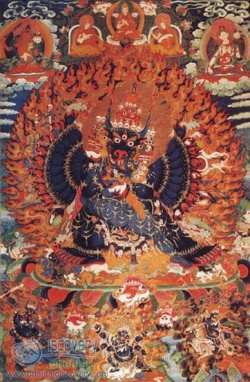Thang-Ka –Ending
The Hayagriva (Horse-headed Vajra), also known as the Horse-headed Avalokites-vara (Tibetan: Rta-mgrin). He is the Garbhadhatu Satyadevata of the Avalokitesvara's Quarters, one of the six Avalokitesvaras, and the god of the animal world. According to Tibetan Esoteric Buddhism, the Horse-headed Vajra is the wrathful manifestation of the Amitabha Buddha of the Boundless Life), and the horse head symbolizes great wrath and power, which, like a heavenly horse sweeping across the land and the sea of life and death, can crush underfoot all demons and barriers of ignorance. He has a dark flesh-tinted body, three faces with two teeth bared, and a halo of angry flames over his back. The Rdo-lo is his devi. The Upper and Lower Tantra Apartments of the Dge-lugs-pa Sect regard the deity as its dharmapala.
The Protector of Life, or Guardian Deity of Life (Tibetan: Tshebdag mgon-po), is a dharmapala of Tibetan Esoteric Buddhism. According to tradition, the deity is the Yama, King of Hell. He has two faces, one genial and the other fearful, symbolizing good and bad karmas.
Manjusri Bodhisattva, known in Tibetan as Vjam-pvi rdo-rje. This deity varies in title and shape. The one holding a sword in the right hand and riding a lion is Manjusri of the Vajradhatu; the one with a green lotus flower in the left hand and seated on a white lotus throne is Manjusri of the Garbhadhatu. The sword symbolizes "the severance of all earthly cares", and the lion signifies the power of wisdom, as Tibetan Esoteric Buddhism believes that "the Mafijugri represents the wisdoms of the Tathagata".
The Supreme Heruka (Tibetan: Bde gshegs sgrub pa bkav brgyad) or the Deva of Eight Methods of the Tathagata. He is the Wrathful Guardian Deity of Tibetan Esoteric Buddhism and the Dharmapala of the Eight Dharmas. This deity, of green colour and with a halo of flames and wings on his back, is multi-faced in different colours. Originally a Bon-po demonic god, he has 18 arms, 8 feet, and embraces the devi Mamo.
The mandala of the Sambara Vajra. The mandala (Tibetan: Dkyil-vkhor), meaning "rostrum ground", used to refer to the round or square mud platform in the middle of a meditation site. Esoteric Buddhists studying the doctrine of a Satyadevata are required to meditate on the mandala of the Satyadevata.
The Skeletons, or the Keepers of Graveyards, are the dharmapalas of the Sambara Vajra. They are so called because in Esoteric Buddhism the principal deities of graveyards are represented by two skeletons which guard the sky burial grounds as defenders of Buddhism. The flaming blue deities which surround the skeletons are the Mahabhairava Vajras.
